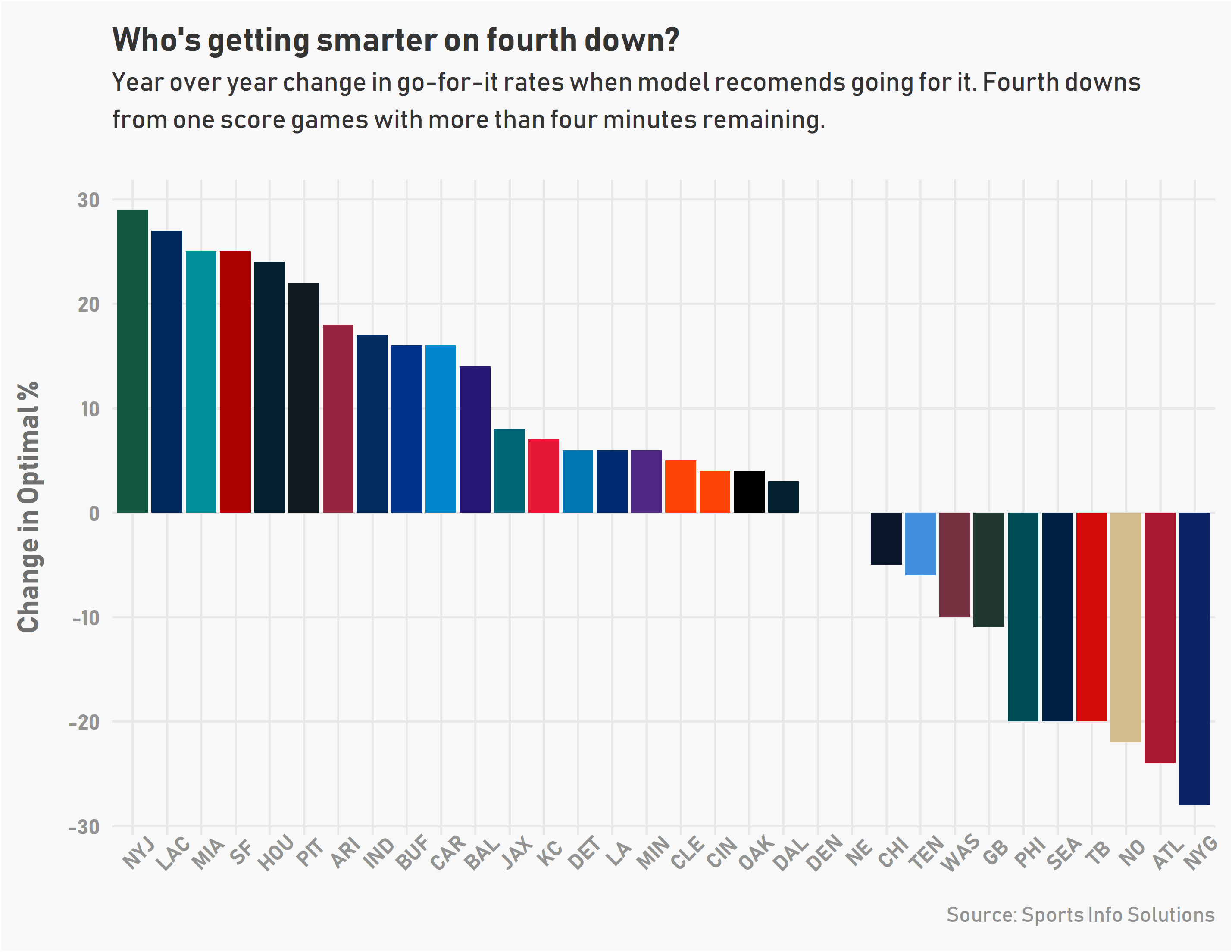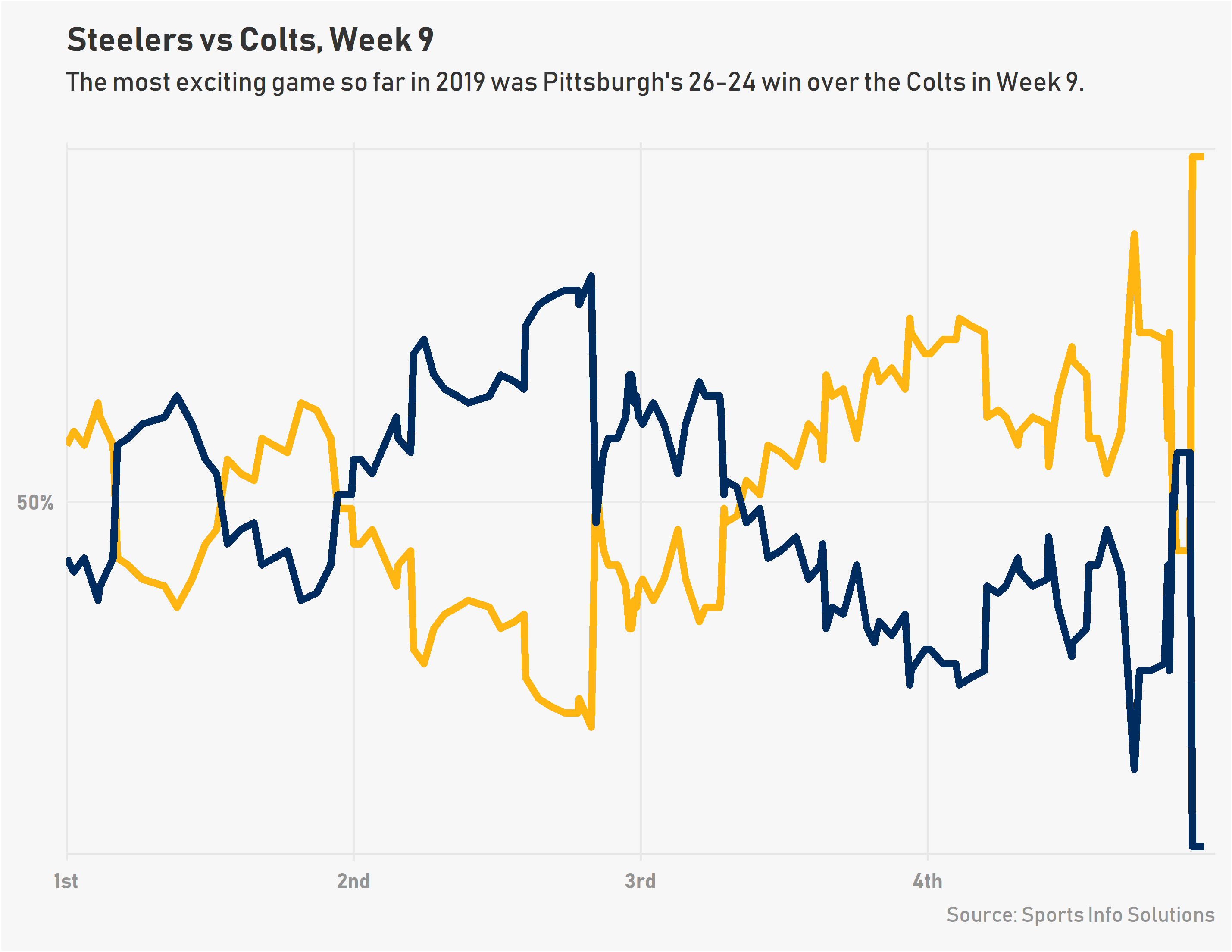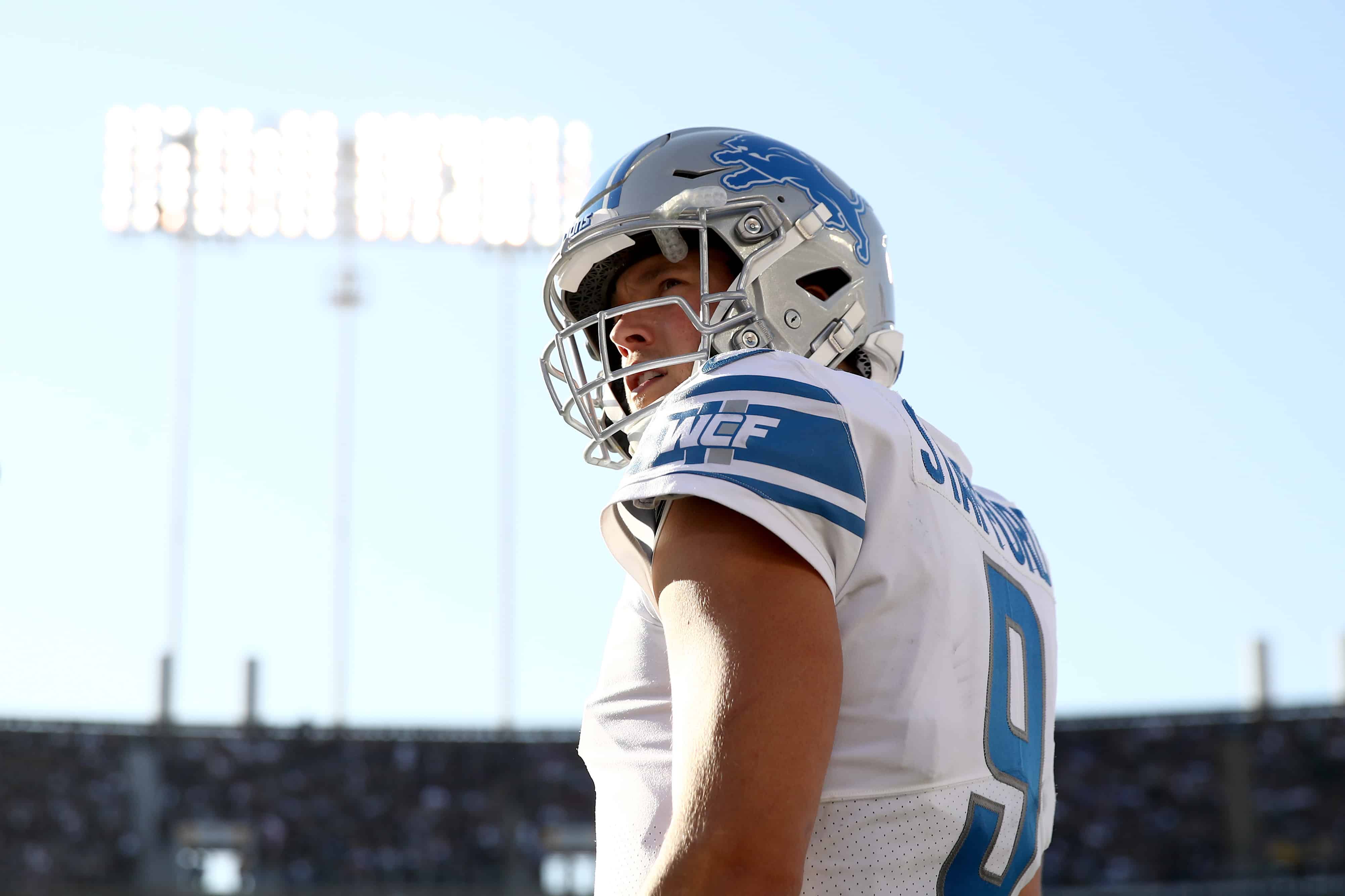At the start of the season, Sports Info Solutions did a detailed study about the different elements that go into fourth down decision making and a number of other win probability related topics. And now, with more than half the season in the books, we can start to take a look back and see if the trends we saw emerging have continued into 2019 and explore some other win probability based odds and ends from the first half of the season.
Are teams getting better on fourth down?
In order to evaluate how well teams are performing on fourth down, we use the SIS Win Probability model to calculate the Expected Win Probability for each of the three options a team has on fourth down: go for it, attempt a field goal, or punt. The calculation for each is based on the win probability of the expected outcomes in each situation. We can write the formula as:
Expected Win Probability = (WP of Success * Chance of Success) + (WP of Failure * Chance of Failure)
We are only focusing on situations in one-score games where the optimal decision would be to go for it. The following plot shows the year-over-year increase or decrease in a team’s go-for-it rate in these instances.

Overall, more teams than not have continued to trend in the right direction in 2019, and only a handful of teams have had drastic decreases. In a surprising turn of events, the Dolphins, Chargers, and Jets find themselves pacing the group. Some of this is because of how poor they were in previous seasons, and some of it is because each of those teams has been on the wrong end of the one-score game criteria more often than not, but it is still a positive sign for three teams that haven’t had a lot of other things go their way this season.
On the other end of the spectrum the Falcons, Eagles, and Packers have the most cause for concern as this marks two years in a row with decreases in optimal go-for-it rates. While the Giants’ massive drop off is concerning given their GM’s checkered past with analytics, they were among the teams who saw the biggest increase in 2018, so it’s possible it’s more of a blip than a long term trend.
Worst Decisions of the Season
Expected Win Probability can also be used at the play level to isolate specific instances where coaches left WP on the table. In this case, “leverage” is defined as the difference in Expected Win Probability between the optimal decision and the second-best option.
| Team | Situation | QTR | Time Left | Lead | Optimal | Actual | Leverage |
|---|---|---|---|---|---|---|---|
| NE vs. BAL | 4TH& 1, Opp 1 | 2 | 0:10 | -7 | Go For It | Field Goal | 15.90% |
| KC vs. DEN | 4TH& 1, Opp 1 | 2 | 8:04 | 4 | Go For It | Field Goal | 10.40% |
| LAC vs. CHI | 4th& 2, Opp 2 | 3 | 0:42 | -9 | Go For It | Field Goal | 10.30% |
| NYG vs. ARI | 4th& 15, Own 33 | 4 | 2:35 | -3 | Punt | Go For It | 9.10% |
| SEA vs. CLE | 4th& 2, Opp 2 | 2 | 7:27 | -11 | Go For It | Field Goal | 8.80% |
It turns out that Bill Belichick is indeed human and capable of the same mistakes that plague so many other coaches. Heading into the half of last Sunday’s game against the Ravens, the Patriots faced 4th and goal from the one down a single score. Rather than going for it and trying to level the game heading into the half, the Patriots settled for a field goal and went into the half trailing by 4.
While Belichick’s error was the most egregious, the rest of the top five make it pretty clear that NFL head coaches aren’t willing to let the goal line field goal die. In a Week 2 loss to the Ravens, Kliff Kingsbury elected to kick a field goal from inside the 5-yard line three different times. In total, the three plays cost the Cardinals 20.3 percentage points of Expected Win Probability.
The Most Exciting Game of the Season
Excitement Index (EI) was originally conceptualized by Brian Burke on his website Advanced Football Analytics, and more recently adopted by FiveThirtyEight for use in college basketball. The basic idea is to calculate the total change in win probability throughout the course of the game, and use that as a proxy for excitement, meaning games that are tightly contested or feature large comebacks and swings in win probability will be the most “exciting”.
Using EI, the most exciting game so far in 2019 was the Week 9 matchup between the Colts and Steelers.

Yes, the most “exciting” game of 2019 was a quarterback duel between Mason Rudolph and Brian Hoyer, which isn’t exactly a marquee matchup. But it’s worth remembering that this is in no way a measure of team quality, but purely a reflection of Win Probability.
Throughout the course of the game the favorite to win changed seven different times, with two of those coming in the game’s final minutes. At the highest, the Colts were given an 82% chance to win, and at the lowest, they were down to a 12% chance to win. On the last drive alone, the Colts went from 26% to 57% before Adam Vinatieri’s field goal attempt went wide left.
This year’s most exciting team
Excitement Index can also be applied on the team level to figure out which teams have been a part of the most exciting games on average. And at the midpoint of the season, the league’s most exciting team is the Detroit Lions with an average Excitement Index of 4.6.
| Team | Average Excitement Index |
|---|---|
| Lions | 4.6 |
| Buccaneers | 4.4 |
| Colts | 4.1 |
| Seahawks | 4.1 |
| Texans | 3.9 |
It is worth reiterating that this is only a measure of fluctuations in win probability, and is in no way a measure of team quality. And with that in mind, it’s hard to deny the Lions the crown.
Their games in 2019 have been decided by an average of four points, with their largest point differential being a 12-point loss to the Minnesota Vikings. The Lions have been within a score of their opponents in the fourth quarter of all of their games this year, including a tie against the Cardinals and a game against the Raiders that came down to the final play.
















